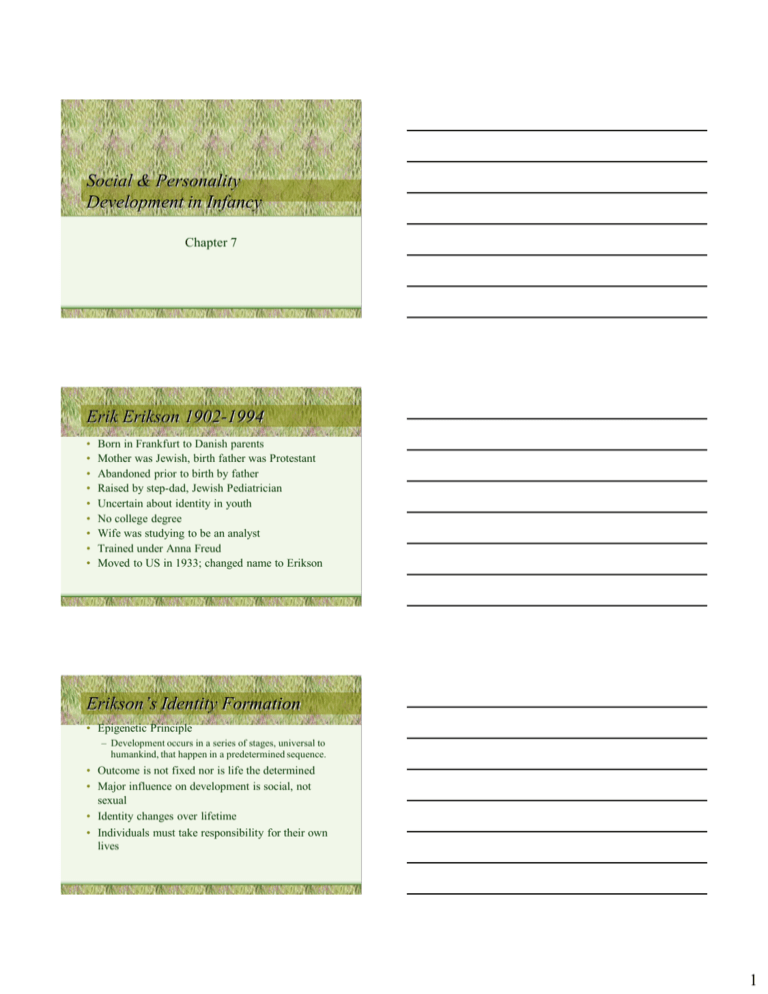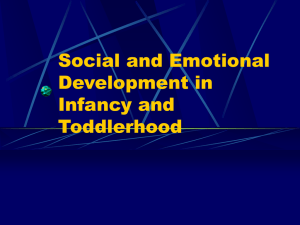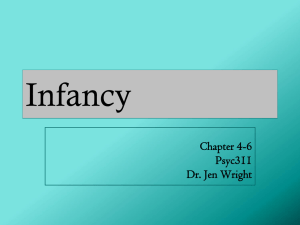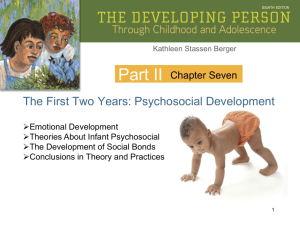Social & Personality Development in Infancy
advertisement

Social & Personality Development in Infancy Chapter 7 Erik Erikson 1902-1994 • • • • • • • • • Born in Frankfurt to Danish parents Mother was Jewish, birth father was Protestant Abandoned prior to birth by father Raised by step-dad, Jewish Pediatrician Uncertain about identity in youth No college degree Wife was studying to be an analyst Trained under Anna Freud Moved to US in 1933; changed name to Erikson Erikson’s Identity Formation • Epigenetic Principle – Development occurs in a series of stages, universal to humankind, that happen in a predetermined sequence. • Outcome is not fixed nor is life the determined • Major influence on development is social, not sexual • Identity changes over lifetime • Individuals must take responsibility for their own lives 1 Stages of Psychosocial Development • Identity develops over 8 stages of life • Each stage is marked by a crisis • Outcome of each stage is dependent on outcome of previous stage & • Successful negotiation of each stage’s ego crisis • “Virtues” are strength that result from successful resolution of the crises Erikson’s Stages 1. Trust vs Mistrust-Oral Stage-Infancy 2. Autonomy vs Shame & Doubt-Anal Stage-Early Childhood 3. Initiative vs Guilt-Phallic Stage-Mid Childhood 4. Industry vs Inferiority-Latency Stage-Late Childhood 5. Identity vs Role Confusion-Genital Stage-Teens 6. Intimacy vs Isolation-Early Adulthood 7. Generativity vs Stagnation-Middle Adulthood 8. Ego Integrity vs Despair-Late Adulthood (Erikson’s theory of psychosocial development, continued) • Infancy marks the time of the TRUST-VERSUS-MISTRUST STAGE (birth to 18 months) during which infants develop a sense of trust or mistrust, largely depending on how well their needs are met by their caretakers. • From around 18 months to 3 years infants enter the AUTONOMYVERSUS-SHAME-AND-DOUBT STAGE during which Erikson believed toddlers develop either independence and autonomy (if they are allowed the freedom to explore) or shame and doubt (if they are restricted and overprotected). Erikson argues that personality is largely shaped by infant's experiences 2 Trust vs Mistrust – 0-18 mo. • GOAL: successful nursing, peaceful warmth, comfortable exertion – HEALTHY BONDING – feelings of trust & hope • Disruption: feeling mistrust & abandonment-insecurity, suspicion of environment-world cannot be trusted • EGO STRENGTH: Hope Autonomy vs Shame & Doubt (1.5-3yr) • GOAL: child have control over body – toilet training – successful difference between right & wrong, control over impulses • Disruption: if overcontrolled & punitivenegative self-image. I am bad, I can never succeed • EGO STRENGTH: Will Stranger Anxiety and Separation Anxiety STRANGER ANXIETY is the caution and wariness displayed by infants when encountering an unfamiliar person. • • • • Appears in the second half of the first year. Infants with more experience with strangers tend to show less anxiety. Infants tend to show less anxiety with female strangers and other children than males. The same cognitive advances that allow infants to respond so positively to those with whom they are familiar also means they are able to recognize people who are unfamiliar. 3 SEPARATION ANXIETY is the distress displayed by infants when a customary care provider departs. • Usually begins about 8 or 9 months and peaks at 14 months • Starts slightly later than stranger anxiety • Largely attributable to the same cognitive skills as stranger anxiety. Both stranger & separation anxiety represent important social progress! They reflect cognitive advances in the infant, and growing emotional and social bonds! Separation Anxiety •Universal phenomenon •Begins at 7 or 8 months •Peaks at about 14 months •Declines after this time More about understanding emotion… Social referencing: Feeling what others feel SOCIAL REFERENCING is the intentional search for information to help explain the meaning of uncertain circumstances and events (modeling others, mimicking expressions) • First occurs in infants at about 8-9 months. • Infants make particular use of facial expressions in their social referencing. • Social referencing is most likely to occur in uncertain and ambiguous situations. 4 Another aspect of social & personality development in infancy: Forging Relationships The most important form of social development that occurs during infancy is ATTACHMENT, the positive emotional bond that develops between a child and a particular individual. Early researchers studied bonds between parents and children in the animal kingdom to understand attachment • Lorenz studied imprinting in animals, the rapid, innate learning that takes place during a critical period and involves attachment to the first moving object observed. Freud suggested that attachment grew out of a mother's ability to satisfy a child's oral needs. • (Early researchers studying attachment, continued) • • Harlow showed, with monkeys, that food alone is insufficient to bring about attachment. In spite of the fact that the wire monkey provided food, the infant monkeys preferred clinging to the warm, terry cloth monkey 5 Based on Bowlby's work, Mary Ainsworth developed the AINSWORTH STRANGE SITUATION The 8 staged episodes of the AINSWORTH STRANGE SITUATION 1. Mother & baby enter an unfamiliar room 2. Mother sits, letting baby explore 3. Adult stranger enters room can converses with mom and then baby 4. Mother exits the room, leaving baby with stranger 5. Mom returns; greets and comforts baby and stranger leaves 6. Mom departs leaving baby alone 7. Stranger returns 8. Mother returns and stranger leaves 6 Infants’ reactions to the strange situation vary considerably, depending on the nature of attachment with mother… a. 2/3 are SECURELY ATTACHED CHILDREN, who use mother as a safe base, at ease as long as she is present, exploring when they can see her, upset when she leaves, and go to her when she returns. a. 20 % are labeled AVOIDANT CHILDREN who do not seek proximity to the mother; after she leaves they seem to avoid her when she returns as if they are angered by her behavior. The Strange Situation Technique • About 12 % are AMBIVALENT CHILDREN who display a combination of positive and negative reactions to their mothers; they show great distress when the mother leaves, but upon her return they may simultaneously seek close contact but also hit and kick her. A more recent expansion of Ainsworth's work suggests a fourth category: DISORGANIZED-DISORIENTED CHILDREN who show inconsistent, often contradictory behavior, such as approaching the mother when she returns but not looking at her; they may be the least securely attached children of all. • The Strange Situation Technique • • Infant attachment may have significant consequences for relationships at later stages in life. Not all children who are not securely attached as infants experience difficulties later in life; some research suggests that those who had avoidant and ambivalent attachment do quite well later in life. 7 Producing Attachment: The Roles of Mother & Father Infants can attach to several caregivers. • Mothers are most often the attachment figure. They are sensitive to their infant's needs. They are aware of the infant's moods. They provide appropriate responses. Attachment styles are stable from one generation to another. • • • • (Producing Attachment: The Roles of Mother & Father, continued) • • • • • Changing societal norms and current research show that some infants form strong multiple attachments, including to their fathers. When stressed, infants tend to prefer their mothers. Almost all fathers do contribute to child care. Fathers engage in more rough-and-tumble play; mothers spend more time feeding and nurturing. Over time, the specific individual that the infant is attached with may change Infant Interactions: Developing a Working Relationship • Variations in attachment highlight the fact that the development of relationships is an ongoing process • Information about the development of relationships during infancy is studied by examining how parents interact with their children – Facial/vocal expressions, games, etc. 8 (Infant Interactions: Developing a Working Relationship, continued) • • Some researchers believe that the development of relationships occurs according to the MUTUAL REGULATION MODEL, which states that infants and parents learn to communicate emotional states to one another and to respond accordingly. Attachment is further increased by the process of RECIPROCAL SOCIALIZATION, by which infant's behaviors invite further responses from parents and other caregivers. Differences among Infants Personality Development and Uniqueness • The origins of PERSONALITY (the sum total of the enduring characteristics that differentiate one individual from another) begin in infancy Another factor contributing to social/personality differences in infants… TEMPERAMENT is the patterns of arousal and emotionality that are consistent and enduring characteristics of an individual. • Temperament refers to how children behave. • Temperamental differences among infants appear from the time of birth. • Temperament shows stability from infancy through adolescence 9 (Temperament, continued) • There are several dimensions to temperament. – – – Activity level is the degree of overall movement. Irritability reflects the fact that some infants are easy-going while others are easily disturbed. (also table 6-2) Alexander, Thomas, and Chess (1984) conducted a large scale study of infants (NY Longitudinal Study) and came up with three profiles of temperament… Alexander, Thomas, and Chess continued Categorizing temperament: Easy, Difficult, and Slow-to-warm babies • EASY BABIES have a positive disposition; their body functions operate regularly and they are adaptable. – • 40 %of infants DIFFICULT BABIES have negative moods and are slow to adapt to new situations; when confronted with a new situation, they tend to withdraw. – 10 % of infants Alexander, Thomas, and Chess continued Categorizing temperament: Easy, Difficult, and Slow-to-warm babies • SLOW-TO-WARM-UP BABIES are inactive, showing relatively calm reactions to their environment; their moods are generally negative, and they withdraw from new situations, adapting slowly. – 15 % of infants. ** The remaining 36 % cannot be consistently categorized. 10 No temperament is inherently good or bad. Long-term adjustment depends on the GOODNESS OF FIT, the notion that development is dependent on the degree of match between children's temperament and the nature and demands of the environment in which they are being raised. Certain temperaments are more adaptive than others • • • • Temperament is a key determinant is the way parents react to the infant's behavior. Temperament seems to be at least weakly related to infants’ attachment to their caregivers Culture also has a major influence on the consequences of a particular temperament (Crying, fussing rewarded in some cultures, punished in others) Buss and Plomin argue that temperament represents inherited traits which make up the core of personality An infant's GENDER, the sense of being male or female, has effects throughout life. It produces dissimilar worlds for members of each sex, even during infancy! Research shows… • Fathers interact more with sons than daughters; mothers more with daughters. • Infants wear different clothes and are given different toys based on gender. • Infants' behavior is interpreted differently depending on gender. 11 (Gender effects on personality & social development, continued) • • • • Male infants are more active and fussier than females. By age one, infants are able to distinguish between males and females. Differences within gender are greater than those between genders. Gender differences become increasingly influenced by gender roles in society. The effects of day care on social and personality development • • 30% of preschool children whose mothers work outside the home spend time in day care centers. More than 80% of infants are cared for by people other than their mothers during their first year of life. Where are Children Cared For? Other 7% Relative’s home 15% Non-Relative’s Home 16% Child’s Home 33% Childcare/preschool 29% 12 Does being cared for outside the home significantly impact infant development? • A large study by the U.S. National Institute of Child health & Development found that high-quality child care outside the home produces only MINOR differences from home care, and may even enhance certain aspects of development! Day Care: assessing outcomes Possible advantages • higher levels of play • more laughing • better attachment • less physically violent • more sociable and cooperative • More independent Possible disadvantages • Less secure attachment • Less obedient • More aggression ~More research is needed! Positive aspects are related to the high quality of the center and the amount of time the infant spends in day care. • Many negative studies conducted in inner city/less well funded day care centers 13







